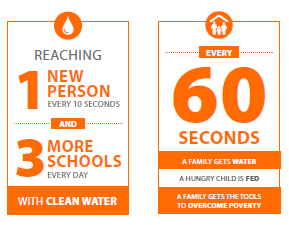Clean Water
World Vision's Clean Water Work
World Vision believes the global water and sanitation crisis can be solved within our lifetimes. That’s why we’re focused on providing clean water and sanitation to every person in every community we work in, including the most vulnerable populations in the hardest-to-reach places.
Thanks to the support of World Vision donors around the world,
World Vision is the largest non-governmental provider of clean water in the world.

Our Clean Water Approach
World Vision’s model focuses on local leadership. Because we invest an average of 15 years in a community, local people take ownership of the water points and learn how to repair them when they break down, making the project sustainable long after World Vision leaves a community. Water projects run in harmony with our other key areas of development: health, education, food, and economic development. This approach to clean water tackles the root causes of poverty, enabling children to experience fullness of life.
In each area, World Vision works with local leaders to determine the best sustainable solution to provide clean water, whether it’s a borehole well, irrigation system, or solar panel—every community is different.

Here are our various methods of establishing clean water systems in communities:
- Drill Rigs: These trucks traverse great distances to drill hundreds of feet underground to tap into water aquifers
- Wells: Hand pumps in the middle of a community allow water to be generated without electricity
- Solar pumps: These panels generate energy from the sun to pull water from pumps and up into storage tanks, and then allow gravity to feed water to various communities
- Pipelines: Pipelines transport water from access points and allow for water distribution across hundreds of miles
- Rain Catchments: Roofs and other kinds of catchments collect rainwater into a storage tank for treatment and distribution
- Water Kiosks: From catching rainwater to receiving water from pumps or pipelines, community members fill up jugs for a small cost
- Latrines & Handwashing: Sanitation and hygiene are promoted by community leaders and practiced with ventilated, improved latrines and handwashing stations
- Repair Mechanics: Local technicians and water users association members are elected to maintain water projects for long-term sustainability
World Vision Well Sustainability
